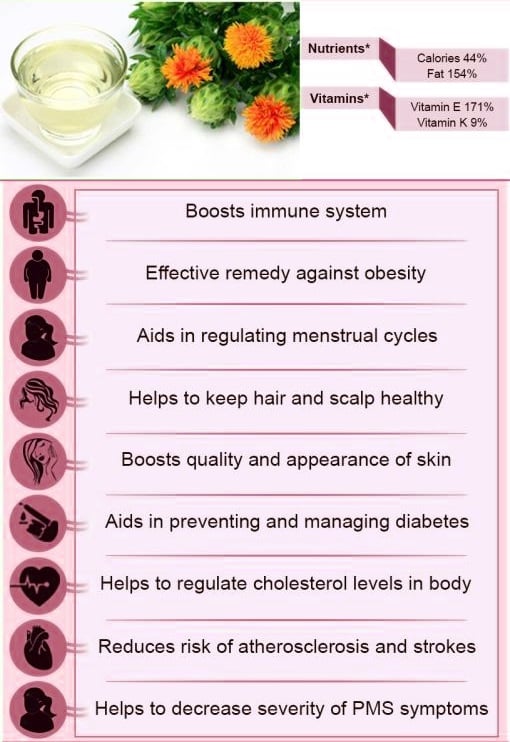- You have no items in your shopping cart
- Subtotal: ₹0.00
Cold Pressed Safflower Oil
Cold Pressed Safflower Oil
Cold Pressed Safflower Oil is a great source of monounsaturated and polyunsaturated fats, Omega-6 fatty acids, Vitamin E, Vitamin K, and phytosterols. The cold press process is one of the most ancient methods of oil extraction, and it ensures that the oil’s natural attributes like TASTE, AROMA, COLOUR, AND NUTRITIONAL VALUES remain intact and fresh. This slow and natural process helps retain the nutritional goodness of the oil.
Safflower oil extracted using this method also contains a good amount of ANTIOXIDANTS. GheeStore is proud to state that our Cold Pressed Safflower Oil is extracted from a traditional wooden churner (ganuga), and is completely UNREFINED.
What is Cold Pressed Safflower Oil?
When you overheat cooking oils, it can destroy beneficial compounds and create harmful free radicals, which damage molecules in your body. That’s why it’s important to use oils with a high smoke point when cooking at high temperatures.
If you’re looking for a cooking oil suitable for high heat, Cold Pressed Safflower Oil may be the right choice for you. It has a higher smoke point than many other oils like corn oil, canola oil, olive oil, and sesame oil. Additionally, it has a neutral flavor, making it an ideal choice for various recipes.
Safflower is a tall plant with spiked leaves and yellow or orange flowers. In ancient Egypt, safflower flowers were used as a dye. Today, some use safflower petals as a substitute for saffron. Safflower seeds are used to produce safflower oil.
There are two varieties of safflower oil: high-linoleic and high-oleic. High-linoleic safflower oil is rich in polyunsaturated fats and is ideal for cold dishes like vinaigrettes. High-oleic safflower oil contains more monounsaturated fats, which makes it perfect for high-temperature cooking.
Is Cold Pressed Safflower Oil Good for You?
When used in moderation, Cold Pressed Safflower Oil is a healthy addition to a balanced diet. It is rich in monounsaturated and polyunsaturated fatty acids, which the American Heart Association refers to as “good fats.” It also contains relatively low levels of saturated fat, which is considered “bad fat.”
Research suggests that daily consumption of safflower oil may help improve blood sugar, cholesterol, and inflammation levels, particularly in individuals with type 2 diabetes. Additionally, the unsaturated fatty acids in safflower oil may help lower bad cholesterol levels.
For a healthier alternative, try using safflower oil in your cooking instead of butter or partially hydrogenated oils. Monounsaturated safflower oil is ideal for high-temperature cooking, while polyunsaturated safflower oil is better for raw preparations or low-heat cooking.
Safflower oil also has cosmetic applications, including use as a moisturizer for dry skin or as a carrier oil for aromatherapy.
Did Someone Say Fried Food?
If you crave deep-fried food occasionally, monounsaturated safflower oil is one of the best oils for frying, as it can withstand high temperatures better than virgin olive oil. Here’s how you can use monounsaturated and polyunsaturated safflower oil in your kitchen:
Monounsaturated Safflower Oil
With a high smoke point, monounsaturated safflower oil is perfect for high-heat cooking. Use it for frying vegetables like zucchini or tempura, making French fries, or preparing stir-fries. You can even bake with it by substituting it for butter or shortening. When baking, use ⅓ cup of safflower oil for every ½ cup of solid fat.
Polyunsaturated Safflower Oil
Polyunsaturated safflower oil is excellent for raw recipes like salad dressings. However, this oil can turn rancid quickly, so always store it in a cool, dark place or refrigerate it.
The Takeaway
Cold Pressed Safflower Oil is rich in healthy unsaturated fatty acids and has a high smoke point, making it suitable for a variety of cooking methods. It’s a healthier alternative to many other cooking oils, but like all oils, it’s high in calories. Enjoy it in moderation as part of a balanced diet, and save deep-fried foods for special occasions.

Cold Pressed Safflower Oil Benefits:
- Reduces Cholesterol
- Lowers Blood Sugar Levels
- Promotes Heart Health
- Strengthens the Immune System
- Supports Women’s Health (especially for premenstrual syndrome)
For more information, visit our Cold Pressed Oil section to explore various oil products.
